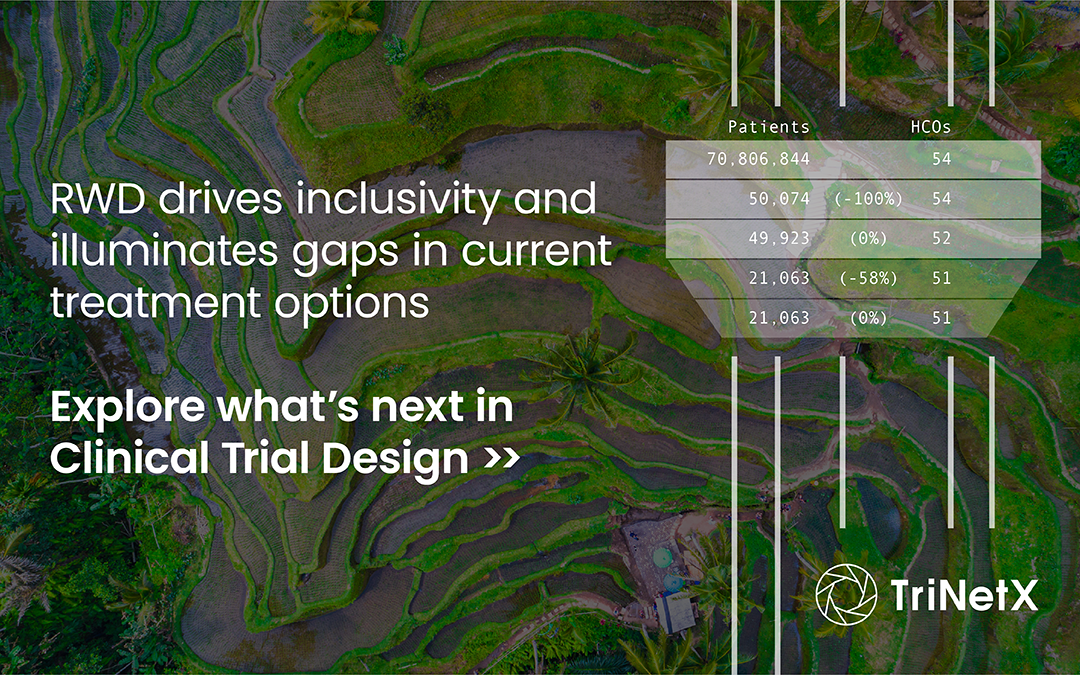
By Arnaub Chatterjee, Chief Solutions and Product Officer at TriNetX
Many clinical trials struggle to enroll patients, hindering meaningful results and delaying the delivery of therapies to patients. Real-world data (RWD) addresses this by overcoming barriers such as overly strict enrollment criteria and disconnects between research design and patients’ lived experiences. By leveraging RWD, global clinical trials are transformed, enhancing patient engagement and improving regulatory decision-making.
Access to rich data enables researchers to understand diverse patient populations worldwide, identifying clinics and hospitals that directly serve these communities. RWD removes knowledge gaps by sourcing from various health care settings: hospitals, clinics, insurance claims records and patient-generated data. The result is a patient pool that better reflects the real world — people of different races, ethnicities, ages, medical histories and socioeconomic backgrounds.
RWD: Streamlining Clinical Trial Complexity
Capturing health information outside the confines of traditional clinical trials offers a raw, unfiltered view of how patients experience diseases, respond to treatments and interact with the health care system in everyday life. Within the digital records of doctors’ visits, lab results and treatment histories lies a wealth of information to advance clinical trial design and execution.
RWD can be used to evaluate trial-eligibility criteria, recruit potential research participants and streamline recruitment. It increases efficiency, leads to shorter timelines and improves patient access to research. Data-driven trials informed by RWD start with a stronger foundation, potentially avoiding mismatched enrollment, unexpected side effects and costly delays that plague traditional trials.
Traditional clinical trials often rely on relatively simple inclusion/exclusion criteria. RWD enables a much more nuanced approach. Researchers can pinpoint patients based on disease variations, previous treatment failures, comorbid conditions (presence of multiple illnesses), or even specific lab values and test results. Such precision reduces the risk of enrolling patients unlikely to benefit from the tested therapy.
Clinical trials must fit within a defined period. RWD provides a longitudinal perspective on diseases that evolve over years or decades. Analyzing long-term patterns in how patients respond to treatments or how their health needs change over time can shape trials that better align with the actual trajectory of chronic illnesses.
RWD illuminates gaps in current treatment options. For instance, if real-world patients switch therapies frequently or experience common side effects, it suggests that better treatment options are needed. For example, clinical trials have limited ability to detect rare side effects. Large-scale RWD can reveal patterns that might emerge slowly or only affect a small percentage of patients. Proactively monitoring RWD allows for identifying potential issues early and modifying ongoing trials to investigate safety concerns.
RWD Drives Inclusivity
Recent FDORA legislation mandates diversity action plans in regulatory submissions for life sciences companies, requiring integrating RWD to enhance patient inclusion.
Historically, underrepresented populations have been sidelined in clinical trials. RWD can help reverse this. Researchers can identify disparities in health care access or treatment outcomes among different groups by analyzing demographic data alongside health records. This knowledge can help shape trial design to intentionally recruit more diverse participants.
Analyzing RWD alongside demographic data empowers researchers to pinpoint specific health care organizations serving diverse communities. This strategy avoids the pitfall of limiting trial locations to major academic centers, which often leads to limited diversity in participant pools.
Using RWD allows for streamlining site identification and accelerates outreach, ensuring trials reach patients from underrepresented groups. Its unwavering focus on inclusivity and precision fuels the development of tailored treatments, ultimately leading to better health outcomes for all.
Learn how the use real-world data on the TriNetX platform can help you explore patient diversity, identify gaps, and improve clinical trial TriNetX | Case studies, publications, and more for RWD expeditions.
Let’s Connect
Continue the conversation around RWD and enhance your research findings with our TriNetX experts.
